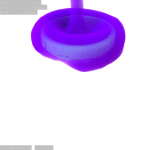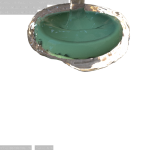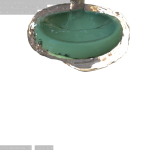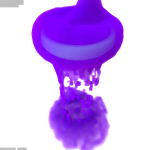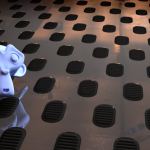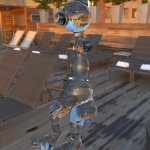And now some coloured smoke in motion, rendered in Cycles. Cool effect, what what.
Tag: test
Quiet One. I have a transmission from your home planet. Would you like to hear it?
I had a yen to mess around with making concentric circles look like they’re talking. I did this in about half an hour with Open Shading Language. The blue rings are driven by frequencies below 500Hz, red is driven by 500-5000Hz, green is driven by 5000Hz and above.
I wrote a technical breakdown here.
This is a special post just for David McSween who is concerned that volumetric rendering is a bit slow. My demo material is a sort of.. grapey.. chocolatey.. gel.. thing. Lighting as ever by sIBL Archive.
Just by itself, the volume part of the material isn’t actually that much more of a CPU hit – in a build from the volumetrics branch:
- a pure glossy surface render takes ~1:59 (volumetrics switched off)
- a pure volume render takes ~2:08
- surface AND volume together take ~2:42
The same pure glossy surface render takes only 1:49 in the official build. So yeah, there’s a speed hit.
Volume rendering a fluid looks like a super-dense gas.
Here is a YouTube link to see it all in motion.
Offered without comment. HDR lighting images from sIBL Archive.
Actually I’ll make one comment: some things are just easier to achieve using geometry rather than texture maps, not to mention looking much nicer and using less verts to get the job done.
I had a hankering to try building a test character using implicit surfaces since that’s what that game Spore used.
Basically instead of describing a surface with verts or NURBS, you use of fields which generate spheres, capsules, boxes and whatnot. When the fields get close enough together, they start to gloop together to create a continuous surface. These objects are known in Blender (and probably in many other 3D apps) as metaballs whether or not they’re ball-shaped.
In Blender at least, metaballs are something of a pain in the arse to turn into characters – you have to parent individual metaballs to individual bones instead of just the usual Armature modifier, and there seem to be weird little rules about what you can and can’t do with them.
There’s an especially weird trap where they are influence-grouped by their name (“family”). One ball becomes the master ball for that “family” and other balls named after it will interact with other members of that family.
Metaballs of the same family all have the same material and threshold of influence. If you want to put a metaball in a different family, you have to rename the object. You can have multiple metaballs per metaball object – the nose and horns on this guy are all one metaball object.
Metaballs can be positive or negative. Negative balls can sculpt away positive balls. As with many things in Blender, extra fun is often to be found by hitting TAB with objects selected. 🙂
So. Not as nice to work with as verts, but as you can see you can make metaballs move around and look vaguely characterish. Even if they’ve got no arms. (The problem with walk cycles is that you can spend all day tweaking them and I have to go to bed at some point. Hence why this sucks a bit.)
Also, IK necks – how good are they? Damn good. Definitely doing more of those.
Barcelona Rooftop HDR background image from here. (sIBL Archives.)
The constructed language has had a first pass in interlinear text. So instead of rushing into writing down actual words, I’m writing down glossed grammatical structures like ART-3s_SENT [planet]-GOAL [far away] fly-PASTPERF-3s_SENT. This lets me sketch the language at a high level without having to invent words or even choose the range of sounds that make up the words first.
I don’t know how this first language fits together well enough to actually translate all the dialogue in the screenplay yet, so I have to go back and decide that some time this week. I’d probably have figured it out tonight if I hadn’t been messing around with metaballs. 🙂

